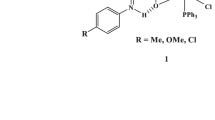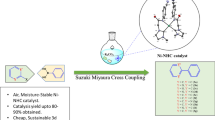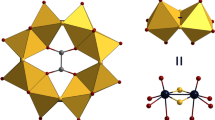Abstract
The [RuCl3(AsPh3)(C3H4N2)2] complex has been prepared and studied by IR, UV–VIS spectroscopy and X-ray crystallography. The complex was prepared in direct reaction of RuCl3·H2O with triphenylarsine and pyrazole in methanol. The electronic structure and UV–Vis spectrum of the obtained compound has been calculated using the TDDFT method.


Similar content being viewed by others
Notes
Each natural bond orbital (NBO) σAB can be written in terms of two directed valence hybrids (HHOs) h A i h B on atoms A and B: \( \sigma_{\text{AB}} = {c}_{\text{A}} h_{\rm A} + {c}_{\text{B}} h_{\rm B}, \) where c A i c B are polarisation coefficients. Each valence bonding NBO must in turn be paired with a corresponding valence anti-bonding NBO:
\( \sigma*_{\text{AB}} = {c}_{\text{B}} {h}_{\text{A}}-{c}_{\text{A}} {h}_{\text{B}} \) to complete the span of the valence space. The Lewis-type (donor) NBOs are thereby complemented by the non-Lewis-type (acceptor) NBOs that are formally empty in an idealized Lewis picture. The interactions between ‘filled’ Lewis-type NBOs and ‘empty’ non-Lewis NBOs lead to loss of occupancy from the localised NBOs of the idealized Lewis structure into the empty non-Lewis orbitals, and they are referred to as 'delocalization' corrections to the zeroth-order natural Lewis structure. The stabilisation energy ∆Eij (kcal/mol) associated with delocalization is estimated by the second-order perturbative as: \( \Updelta {E}_{ij}= {q}_{i} \left({F}\left({i, j}\right)^{2}\right)/(\varepsilon_{j} - \varepsilon_{i}), \) where q i is the donor orbital occupancy, ε i , ε j are diagonal elements (orbital energies) and F(i,j) is the off-diagonal NBO Fock or Kohn–Sham matrix element.
References
Panda BK, Sengupta S, Chakravorty A (2004) Eur J Inorg Chem 178
Wong WK, Chen XP, Guo JP, Chi YG, Pan WX, Wong WY (2002) J Chem Soc Dalton Trans 1139
Naota T, Takaya H, Murahashi S-I (1998) Chem Rev 98:2599
Frisch MJ, Trucks GW, Schlegel HB, Scuseria GE, Robb MA, Cheeseman JR, Montgomery Jr JA, Vreven T, Kudin KN, Burant JC, Millam JM, Iyengar SS, Tomasi J, Barone V, Mennucci B, Cossi M, Scalmani G, Rega N, Petersson GA, Nakatsuji H, Hada M, Ehara M, Toyota K, Fukuda R, Hasegawa J, Ishida M, Nakajima T, Honda Y, Kitao O, Nakai H, Klene M, Li X, Knox JE, Hratchian HP, Cross JB, Adamo C, Jaramillo J, Gomperts R, Stratmann RE, Yazyev O, Austin AJ, Cammi R, Pomelli C, Ochterski JW, Ayala PY, Morokuma K, Voth GA, Salvador P, Dannenberg JJ, Zakrzewski VG, Dapprich S, Daniels AD, Strain MC, Farkas O, Malick DK, Rabuck AD, Raghavachari K, Foresman JB, Ortiz JV, Cui Q, Baboul AG, Clifford S, Cioslowski J, Stefanov BB, Liu G, Liashenko A, Piskorz P, Komaromi I, Martin RL, Fox DJ, Keith T, Al-Laham MA, Peng CY, Nanayakkara A, Challacombe M, Gill PMW, Johnson B, Chen W, Wong MW, Gonzalez C, Pople JA (2003) Gaussian 03, Revision B.03. Gaussian, Inc., Pittsburgh
Becke AD (1993) J Chem Phys 98:5648
Lee C, Yang W, Parr RG (1988) Phys Rev B 37:785
Casida ME (1996) In: Seminario JM (ed) Recent developments and applications of modern density functional theory, theoretical and computational chemistry, vol 4. Elsevier, Amsterdam, p 391
Eichkorn K, Weigend F, Treutler O, Ahlrichs R (1997) Theor Chim Acc 97:119
Glendening ED, Reed AE, Carpenter JE, Weinhold F (1992) NBO (version 3.1)
Desiraju GR, Steiner T (1999) The weak hydrogen bond in structural chemistry and biology. Oxford University Press, Oxford
Jeffrey GA, Saenger W (1994) Hydrogen bonding in biological structures. Springer, New York
Taylor R, Kennard O (1982) J Am Chem Soc 104:5063
O’Boyle NM, Tenderholt AL, Langner KM (2008) J Comput Chem 29:839
Author information
Authors and Affiliations
Corresponding author
Appendix: supplementary data
Appendix: supplementary data
CCDC 675490 contain the supplementary crystallographic data for [RuCl3(AsPh3)(C3H4N2)2]·0.5CH3OH complex. These data can be obtained free of charge via http://www.ccdc.cam.ac.uk/conts/retrieving.html, or from the Cambridge Crystallographic Data Centre, 12 Union Road, Cambridge CB2 1EZ, UK; fax: (+44) 1223-336-033; or e-mail: deposit@ccdc.cam.ac.uk.
Rights and permissions
About this article
Cite this article
Małecki, J.G., Kruszynski, R. The new arsine ruthenium(III) complex with pyrazole ligand. Struct Chem 21, 637–641 (2010). https://doi.org/10.1007/s11224-010-9593-y
Received:
Accepted:
Published:
Issue Date:
DOI: https://doi.org/10.1007/s11224-010-9593-y




